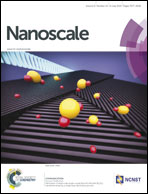Novel Li2MnO3 nanowire anode with internal Li-enrichment for use in a Li-ion battery†
Abstract
Anode materials which undergo a conversion reaction can achieve larger specific capacities than conventional carbon-based materials. They can even achieve higher energy densities when used at low voltages. However, the large amounts of Li2O generated in the interior of these structures when Li ions are inserted can cause volume expansion and mechanical fracturing from the inside out. This leads to a poor cycling performance and limits their commercial application. To overcome this limitation, we introduced Li ions into the interior of the cells of manganese oxide materials and successfully synthesized a novel Li-rich anode material (Li2MnO3). The reversible capacity reached 1279 mA h g−1 after 500 cycles, much higher than that of pure MnO2 or other commercial anodes. This optimization of the internal Li-enrichment and its application in Li2MnO3 nanowires used as low voltage anodes in Li-ion batteries have rarely been reported. Further investigations by X-ray diffraction and photoelectron spectroscopy suggested that the strategy of optimizing the internal Li-enrichment of this novel Li2MnO3 anode is a promising development for Li-ion batteries.


 Please wait while we load your content...
Please wait while we load your content...